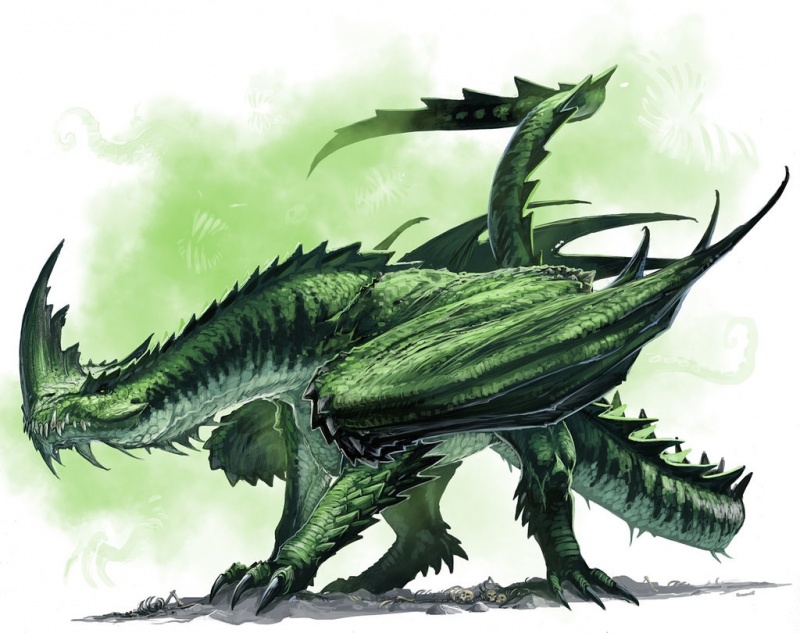Common Green Dragon (Basic Lore)
Common Green Dragon (Threat; CR 13) |
|
| Pure Evil - Huge - Dragon | |
| This creature possesses the Threat role, and therefore counts as 4 monsters for purposes of encounter size, XP award, and treasure.This monster frequently has the Threat role, but may be set to other roles if desired.
Dragons are so different from every other creature that they have their own unique classification. They have four legs, although the front 'feet' are dexterous enough to serve quite well as hands. They also have two or more completely functional wings, and they are powerful and speedy fliers. They have a large and dexterous prehensile tail, and seeing a monster as big as a dragon hanging from a branch is a sight you will remember for the rest of your life, however long that might be. Dragons are intelligent and terribly alien. What a dragon considers important is not what other races consider important. They are also frequently, but not always, intensely malign. Some rare dragons may be allies with lesser races (all races are lesser to a dragon, as they see it) or even genuine friends to others. Most dragons, even those traditionally considered "good," are vain and jealous things, consumed with petty grievances and cruel enough to punish every slight, no matter how small or imaginary. Dragons will hunt at great distances. Due to their powerful and magically enhanced metabolisms, dragons need to eat far less than would seem 'natural' for a beast their size. Rather than a blessing, this is a terrible curse upon the world, because things as awful as dragons should be rare, and, as the name "common red" might imply, they are not. Even worse, since dragons need far less food than is natural, they tend to be horrifically picky eaters, and have been known to kill an entire herd of cows to find the tastiest one, or rampage through an entire town looking for the prettiest maiden. Dragons also have a tendency to 'play' with their food in most terrible ways. If you want to rescue that prettiest maiden, best to be quick about it. It is often speculated that dragons are deliberately wretched in their behavior, in order to force would-be dragon-slayers into action 'before they're ready', and so increase the dragon's long-term safety. Indeed, many dragons are far too intelligent and clever for their own good. There are hundreds of stories of adventurers taunting dragons into foolish actions, and it is true that, in a battle, it is hard for a dragon to take any 'lesser' race seriously. In a dragon's mind, the only creatures worthy of consideration, much less respect, are other dragons. The world belongs to the dragons. The rest of us just live here. Dragons tend to be categorized into loose species-groups based upon their physical appearance and traits. Most common among these are the white, black, blue, green, red chromatic dragons, followed closely by the bronze, copper, silver, gold and platinum metallic dragons. Other species groups exist, such as the earth dragons (brown, gray, yellow, and ocher), the spirit dragons (force, prismatic, empyrean, and tellurian) the gem dragons (crystal, onyx, jade, sapphire, ruby and amber), the drifting dragons (cloud, mist, shadow, sand, and dust), and the tempered dragons (iron, steel, mithril and adamant), to name the most common. In addition there are many odd dragons which defy categorization, such as coiled dragons, nested dragons, radiant dragons, sea dragons, celestial dragons, star dragons, moon dragons, sun dragons, fairy dragons, and many, many more besides. While the physical appearance of the dragon is the easiest means of distinguishing them from one another, a dragon's coloration isn't a drab monochrome. Green dragons, for example, are mottled with browns, tans and olive colors in addition to their base green color, allowing them to effortlessly blend into flora-rich environments. While they prefer forests and other areas with ubiquitous flora, green dragons can be found nearly anywhere. Green dragons are unique in several ways from other traditional dragons. First, while they are quite competent fliers, they are also absurdly quick climbers, able to slither through forest branches with terrible grace. Second, they always have at least two tails (and sometimes more than two), each carrying a straight, poisoned barb on the end. While in motion, the tails do not appear disproportionately long, but in combat, they can stretch them to startling lengths attacking distant foes with surgical precision. |
